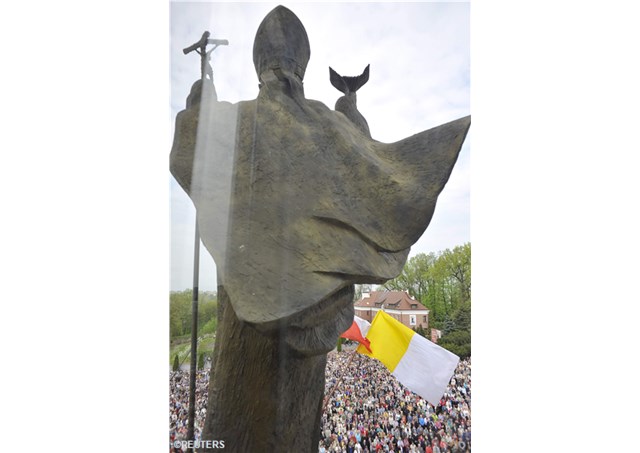
Spotlight on the devotion to Divine Mercy

(Vatican Radio) This past week a Church in the heart of Rome, that of S. Andrea della Valle, became the location to celebrate the European Apostolic Congress on Mercy. At least for the first two days, that’s to say from the 31st to the 1st of April. And on Sunday 3rd of April, Divine Mercy Sunday, there will be Holy Mass in Saint Peter’s Square presided over by Pope Francis in St Peter’s Square.
That's eleven years on from the death of John Paul II on the 2nd of April 2005, who as we know was canonised on Divine Mercy Sunday. No surprise given his special devotion to Divine Mercy.
To mark the day the Church celebrates the Feast of Divine Mercy Veronica Scarisbrick tells the story linked to this devotion.
Listen to a programme focusing on the devotion to Divine Mercy presented and produced by Veronica Scarisbrick:
It’s a Polish story which takes us to a leafy Kraków suburb by the name of Łagiewniki. At a time in history when this nation was behind a so called 'iron curtain’ and under the yoke of a communist regime. And when Karol Wojtyla, the future Pope John Paul II, was growing up in the nearby town of Wadowice.
Today in this place there stands a Shrine where pilgrims flock. It’s that of ‘Divine Mercy’. One Pope Francis is scheduled to visit at the end of July when he travels to Kraków to preside over ‘World Youth Day’ during this Jubilee Year dedicated to Mercy.
He’ll be doing so in continuity with two of his predecessors to the See of Peter. The last being Benedict XVI, now Pope Emeritus. And the other you’ll have guessed is the Pope from Poland, Saint John Paul II, who first launched ‘World Youth Days’.
So Francis then will be going to a place linked in a special way to the visions of a Polish sister by the name of Faustina Kowalska who lived and prayed there in the first half of the twentieth century. And was later canonised by John Paul II during the Jubilee Year 2000.
But let’s glance at how this devotion came about and at its message. The date was the 22nd of February 1931 with the first of a series of ‘Apparitions’ which Sister Faustina describes in a diary of some 600 pages, a personal witness of divine revelations and mystical experiences.
This diary written in a ‘spidery’ like calligraphy unveils a powerful message of hope in a world in the shadow of the fearful humanity of the time. But also reveals an image of that ‘Apparition’ of the Lord Jesus who appeared to her clothed in a white garment with two rays of light emanating from His breast one red and one white. The red, she writes, symbolic of blood representing the life of souls and the white symbolizing water which makes souls righteous. These are her exact words: “In the evening when I was in my cell, I saw the Lord Jesus clothed in a white garment. One hand was raised in a gesture of blessing, the other was touching the garment at the breast. From beneath the garment, slightly drawn aside at the breast, there were emanating two large rays, one red, the other pale. In silence I kept my gaze fixed on the Lord. My soul was filled with awe, but also with great joy. After a while, Jesus said to me: ‘Paint an image according to the pattern you see, with the signature Jesus, I trust in You. I desire that this image be venerated, first in your Chapel, and then throughout the world.”
And at the Łagiewniki Shrine of ‘Divine Mercy’, a copy of this painting of the ‘Merciful Jesus’ stands above the main altar. The original is to be found only yards away in the tiny chapel where Sister Faustina once prayed following her first vision.
At the ‘Dedication Mass’ of this large new Basilica on the 7th of August 2002, John Paul II mentioned in a moment of nostalgia how he used to come to this same chapel to pray as a young man whenever he went by on his way to work at the Solvay Chemical Plant nearby. As he rather famously remarked on that occasion: “Who would ever have imagined that the young man in his wooden clogs would one day be back here in his capacity as Roman Pontiff to dedicate a new Basilica dedicated to Divine Mercy”.
Earlier still, during the homily he had highlighted the spiritual importance of the message of mercy at a time when mankind was experiencing bewilderment in the face of many manifestations of evil. How greatly the world needs God’s mercy, he insisted: “In every continent, from the depth of human suffering, a cry for mercy seems to rise up. Where hatred and the thirst for revenge dominate, where war brings suffering and death to the innocent, there the grace of mercy is needed in order to settle human minds and hearts and to bring about peace. Wherever respect for life and human dignity are lacking, there is need of God’s merciful love, in whose light we see the inexpressible value of every human being. Mercy is needed in order to ensure that every injustice in the world will come to an end in the splendour of truth”.
What began as a very Polish devotion has now spread right across the world. And in July when Pope Francis travels to Kraków for World Youth Day no doubt many thousands of young pilgrims from the four corners of the earth will rally around him during this Jubilee Year dedicated to Mercy. Here at the Shrine of “ -Łagiewniki" where the legacy of Saint Faustina Kowalska lives on in a special way.
| All the contents on this site are copyrighted ©. |


